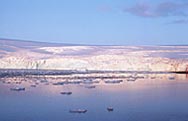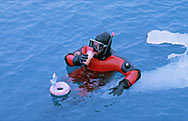Once in a while chance brings along an experience that one knows will be preserved in memory for life. This afternoon was one of those times for six of us.We awoke this morning to a low fog that kept us from seeing even the opposite side of Hero Inlet, just a few hundred yards away off the station boat dock. But we could see up through the fog to a blue sky and anticipated a pretty day in the field. The good thing about fog is that it means that there isn't much wind, and it was high winds that hampered our field work for the first few days. "Dive ops" (i.e., diving operations) would commence after lunch.
Lunch came and went but the fog stayed. Finally about 2:30 p.m. it was beginning to lift. With compass, GPS, and the station boating coordinator to guide us, we headed out into the fog across Arthur Harbor and towards Janus Island. Named for the Roman deity who was the guardian of gates, Janus Island is about 1.3 nautical miles from the Station and guards the southwest entrance to the Arthur Harbor area.
Ross Hein, the boating coordinator, is also a skilled scientific diving expert with more dives in his log than our entire science team combined (and several of us have more than a few). The plan was to do a fairly technical dive along a vertical wall on the exposed side of the island. We chose this spot because Ross had previously seen a number of organisms of great interest to us there.
The plan was that Katrin and Bill would follow Ross and me into the water, two buddy teams staggered with the second one going in soon before the first was due out. We have a number of different signals between divers and between the boat tenders and divers in the water. One of those is banging on a scuba tank held over the side of the boat if a tender sites a leopard seal. That tells the divers to swim up slope and haul themselves out on the rocks if possible, which is the safest thing to do since the steep shore can protect the divers' backs while they come up. Someone commented as Ross and I were suiting up that we didn't have a diver-to-diver signal for leopards, and so we devised one: a hand and thumb "jaw" motion in front of your face.
Because of the exceptionally steep slope and also the potential for strong currents, we utilized a "live boat" that would drop us off and then keep near but not right over us during the dive instead of trying to anchor. With Jim at the helm and Joanna as the second dive tender, Ross and I jumped off the boat over a small ledge. The ledge was in about 30 feet of water, just inshore of the wall, and was only about 30 feet from the rocky south shore of Janus. We dropped down to the ledge and then immediately over the edge and down the wall. We sank feet first, adding bursts of air to our dry suits as we "took the elevator" into the depths -- enough air to control our descent but not to stop the elevator.
The wall was a dense macroalgal forest, rich too with a diversity of invertebrates beneath the algal canopy. We leveled off just above 120 feet and quickly went to work. Our plan was to collect there for only a minute or two and then to go immediately above 100 feet, at which point we would make a gradual ascent up the wall, collecting as we rose. I immediately found a species of deep-growing macroalgae important for Andy's dissertation research and Ross collected some new (to us) sponge species.
A fairly strong long-shore current pushed us westward as we worked up. We found ourselves in an unusually rich and diverse zone of octocorals from 95 to 75 feet. At about 70 feet the current slacked off somewhat and we made a concerted effort to work our way back eastward as we collected our way upwards.
The wall was among the most remarkable places I've been, above or below the oceans' surface. I wish that I had the literary skills to adequately describe the magnificent beauty of this undersea wonderland but it is simply beyond my ability. To just say that it was spectacular is inadequate, but among many other things, it surely was that.
-- To be continued...



